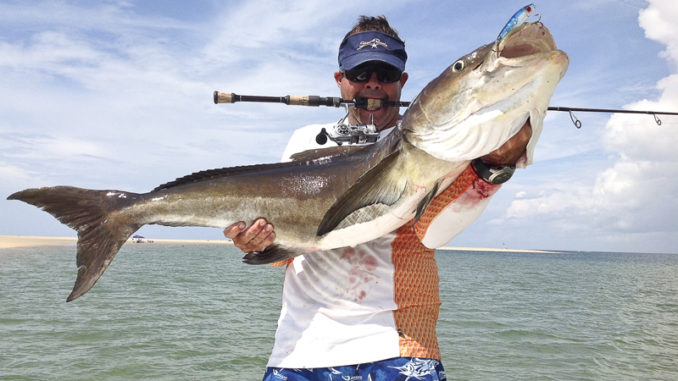
May is the prime month for cobia along the Carolina coast. Be ready when one swims within casting distance of your boat; you can’t miss chances like that.
Spring wouldn’t be complete without the annual cobia run along the Eastern Seaboard. As the weather warms the ocean waters along the Carolina coast, winterized cobia hanging around in waters off Florida venture north. They head back to their summer stomping grounds, following schools of menhaden and other baitfish.
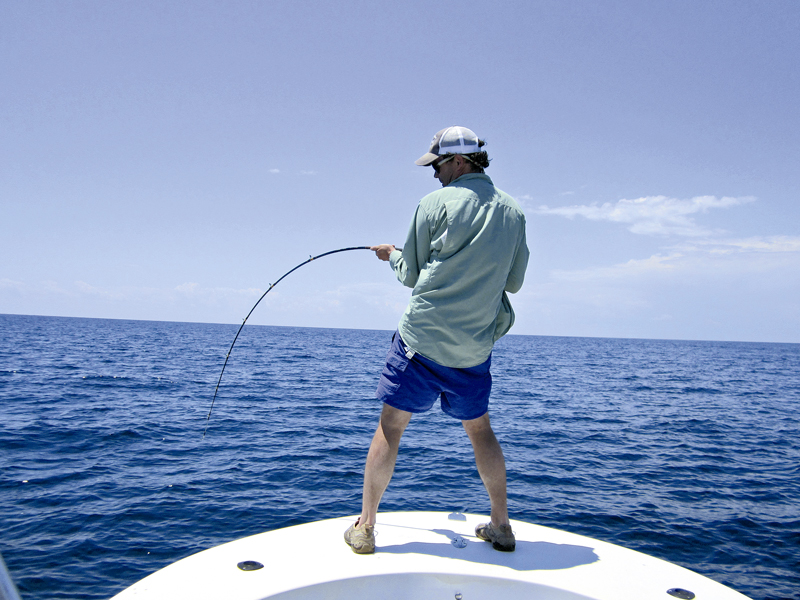
Anglers from Hilton Head, S.C., to North Carolina’s Outer Banks begin scanning nearshore habitats this month for these brown cruisers. When they show up, experienced fishermen will be there. And equipped for the quick draw to feed a hook to one of these mighty submarines.
Cobia travel hundreds of miles annually like many migrating pelagic fishes. They cross more than 12 degrees of latitude in each direction. Hilton Head anglers are the first to see them. Here, they show up in late March through early April. Every few weeks, cobia are spotted in Charleston, Myrtle Beach, Southport and Morehead City on their way up the coastline to the Outer Banks and beyond. When they begin to arrive, a typically steady stream of fish swims through daily from April into June.
In Charleston, S.C., Capt. Ben Powers of Reel Time Charters begins to see cobia in his waters in April.
Cobia fishing gets hot in Charleston this month
“Cobia start to trickle in around the middle of April, typically, depending on water temperature, moon phases and bait availability,” said Powers (843-475-9660). “May is our best cobia month, though. It is hot and heavy in May.”
Powers begins looking for cobia in April. But first, he pays close attention to message boards and online reports out of Jacksonville, Fla., and Savannah, Ga.
“I pay attention to the reports along the east coast. You can track them as they work their way up the coast,” he said.
When the arrival of the first fleet of cobia is imminent, Powers prepares the battle gear on his boat to make sure he has the flavor of the day. Cobia are voracious predators. They eat just about anything with a fin. But at times, they can be selective about what baits or lures they’ll eat.
“It’s important to be ready for them at all times,” he said. “Cobia can be very picky or eat anything you toss at them. They often want one specific bait, like a soft eel, bucktail, big swimbait or just a live, swimming menhaden,” he said.
Powers rigs four rods and feels like his choices are enough to tempt a cobia into taking the plunge.
Always carry live bait on cobia trips
“I rig up four rods to cover the entire water column,” he said. “I use a 3- to 4-ounce bucktail to get to the bottom quick. A 7- to 8-inch swimbait on a ¾-ounce jighead covers the mid-column. A Shimano Orca Popper or eel works on the surface. I’ll also have a live menhaden on a 5/0 to 6/0 circle hook tied with an FG knot on a 10-foot fluorocarbon leader,” he said.
Powers rarely fishes without live bait onboard during the spring cobia run. He always nets fresh bait on his way out to ensure he has some lively swimming options in his arsenal. Live bait is something that generally triggers a quick response from a floating cobia. But these artificial options can be super deadly when these fish are looking for something a little different and need a little enticement.
“It’s critical to have all four rod setups at your fingertips when you leave the dock, because you will not have time to tie on something different when you pull up on a fish or when the fish is refusing a bait or lure,” he said. “They will also disappear just as fast as you initially spotted them. You have to be ready.”
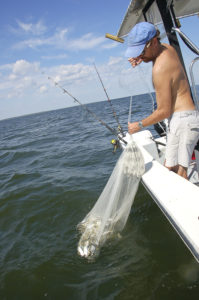
Cobia are highly mobile this time of year. And they often appear or vanish in plain sight. They are top-level predators and are attracted to places where feeding is easy. In May, they find nearshore areas abundant with baitfish. They use the immediate coastline as a navigational pathway, stopping along the way to feed before migrating further north.
Carolina coastline offers perfect cobia habitat
The entire Carolina coastline offers cobia plenty of nearshore feeding options, including the many inlets and structures available.
“Cobia will typically hang around deeper channels around some sort of structure or current edge,” said Powers. He fishes a wide variety of habitat types, and his search rarely ends up short during May. “The first place I look are around the channel markers. These fish will float on the leeward side of these cans.”
If channel markers aren’t holding any fish, he will head out the nearest inlet and hit the tide line a couple miles off the beach.
“Where the brown and green waters meet, you get a tide line, and it will have baitfish suspended around the dead marsh grass and other floating debris,” he said. “These tide lines can be excellent places to find cobia this time of year all up and down the coast.”
Don’t forget about livebottom
Lastly, Powers will target livebottom and nearshore reefs, which hold plenty of baitfish. They’re buffet lines to migrating cobia. When other places fail, the nearshore livebottom often produces a solid opportunity for a hookup.
Cobia season gets cranked up in April and typically peaks in North Carolina and South Carolina waters during May. Every day can be different. The prime place one day may be cold the next. Successful anglers are accustomed to this type of sporadic action and understand that moving around from one spot to the next to find fish is the name of the game. But a quick draw is also a critical tool to have in the toolbox.
“You need multiple options rigged up and ready to throw. Being prepared for every opportunity is key to catching a cobia or watching them swim off,” he said.
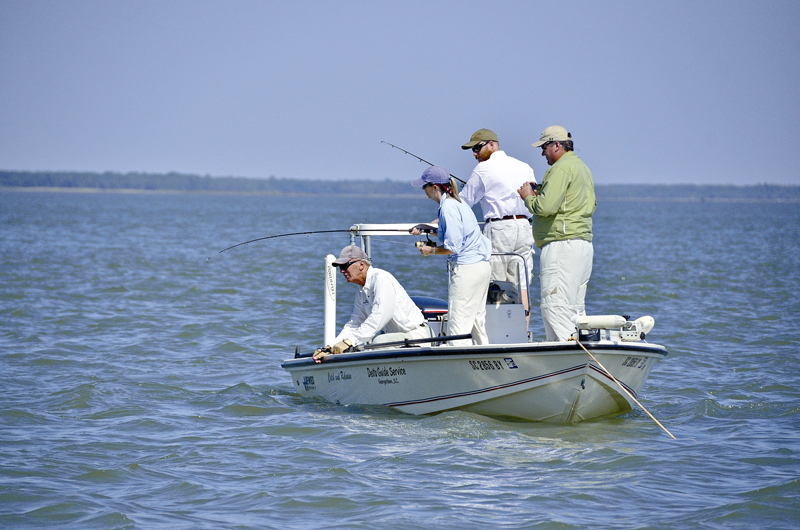
Carolina Cobia Regs
South Carolina and North Carolina manage cobia in state waters with different creel and size limits.
South Carolina allows a single fish per day — and six fish per boat — with a 36-inch size minimum, except in that area south of Jeremy Inlet, a relatively small inlet that divides the Edisto Island beach in half. No cobia may be kept south of Jeremy Inlet from May 1-May 31. And after June 1, anglers are allowed one fish per day, up to three per boat.
From May 1-31, North Carolina allows fishermen on private boats to keep one cobia per day and two per vessel per day, with a 36-inch size minimum. After June 1, vessels are limited to one fish per day.
On charter boats, anglers can keep one cobia per day, with a four-per-day vessel limit.
Both states measure cobia from the nose to the forks of the tail.
Cobia like company
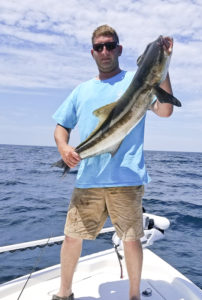
Cobia are one of the most-coveted spring fishing opportunities along the south Atlantic coast, from their strenuous battles to their exquisite flesh, and many anglers hit the water at the first sign of their arrival. In turn, most anglers expect plenty of company in places that typically attract these migratory fishes. But these fish also like company — from other cobia and from anglers’ boats.
One of a cobia’s most-unique features is a general lack of fear. They are not as spooky as many other gamefish — redfish, trout and king mackerel come to mind. In fact, cobia are well known to swim right up alongside the boat.
Furthermore, cobia arrive in Carolina waters in relatively small packs, in different locations. Guide Ben Powers is accustomed to these brown submarines pulling right up next to his boat.
Be ready to sight cast to cobia
“Cobia are drawn to structure and anything that provides them with cover — like your boat,” he said. “It’s one large structure on the surface. They will come check you out, and you can sometimes pitch a bait or lure right to them and hook up instantly.”
Cobia typically ride high in the water column and can be easily seen in the clear water along the oceanfront. So anglers have the opportunity to pitch baits to them.
Powers also encourages cobia anglers to keep fishing after a fish is boated.
“These fish are traveling in groups, even if you can’t see them all. On average, there are six to eight together. Even if you only see one or only catch one, stay put because more are typically around, floating deeper in the water column you can’t see,” he said.




Be the first to comment